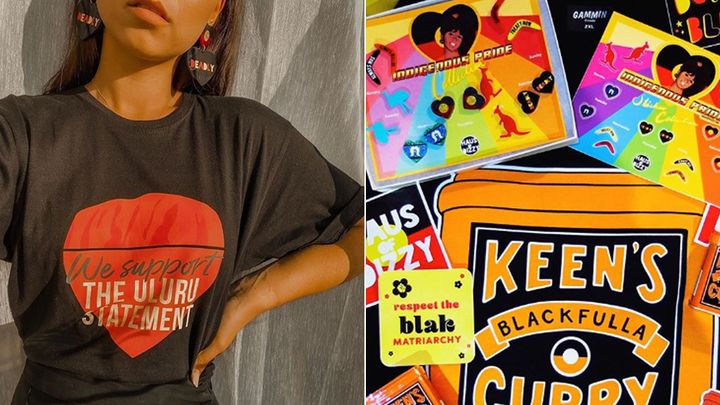
As January 26 draws closer, debate about changing the date of Australia’s national holiday ramps up but so does the feeling of anxiety and loss among Indigenous people.
Political issues aside, Survival Day is an opportunity to celebrate Indigenous excellency and, according to Tiddas 4 Tiddas co-founder Marlee Silva, “talk about the resilience of our people, demonstrated in how Indigenous Australians have survived all we have since this first point of invasion.”
One way of being an ally this Survival Day is to support Indigenous business. In fact, there is a whole Instagram account, Blak Business, dedicated to sharing the works of mob all over Australia.
Olivia Williams, a proud Wiradjuri woman, runs the account and provides followers with accessible explainers on various topics around Indigenous Australia.
“Purchasing and wearing merchandise such as jewellery, clothing and tote bags from Aboriginal and Torres Strait Islander businesses is one way allies can support the Indigenous community,” she said in an Instagram post while breaking down the question “is it OK for non-Indigenous people to wear Indigenous merch?”
While acknowledging there is no right or wrong answer, Olivia said “many Indigenous businesses and creators create their merchandise for the general population and take pride in seeing their goods being celebrated and worn throughout society by both Indigenous and non-Indigenous people.”
Blak Business highlights that Indigenous merch provides representation in the wider community and can be utilised to shine a light on Indigenous culture and issues in spaces where those conversations may not have previously happened.
“For this reason, it is important that allies know who they are buying from and what the merchandise is about,” Olivia said.
Olivia also urged buyers to be thoughtful and selective about what merch they choose to wear. For instance, fashion that explicitly represents the Indigenous community is often seen as inappropriate for non-Indigenous people to wear, for example, a T-shirt that says “Blak Girl Magic” or “Straight Out of Dreamtime.”
“These pieces are not intended for non-Indigenous people,” Olivia explained.
“There’s lots of great Blak businesses for you to support, and we hope you find one that resonates with you.”
Here are some examples of Indigenous business you can buy from right now:
Haus of Dizzy
These gorgeous accessories by Kristy Dickinson have been worn by the likes of Lauryn Hill. Kristy told Marlee Silva on Mamamia’s Tiddas 4 Tiddas podcast the name Haus of Dizzy came from a Newtown house party she threw with her roommates because Dizzy was a term of endearment to her best friends.
Indigenous pride pieces include ‘Sovereignty Never Ceded’ and ‘Always Was, Always Will Be’ earrings.
“These are a range that I have made to remind us of our history and how strong and resilient our First Nations people are,” Kristy wrote on Instagram.
“We have survived so much in our lives and we keep on surviving!”
Warralang Projects
Warralang Projects is a Canberra-based business that provides services in design, printing and promotional products. Started by proud Bundjalung, Yuin man Steven Brown, who mentors Indigenous youth, the company was created in 2016 after encouragement from Steven’s community.
“I’ve always provided support to people I know but never charged for it,” Steven told HuffPost Australia.
“I figured if I’m going to use my skills, why not get paid for it and hopefully employ myself full time in the future. My dream is to be large enough to employ a number of other Aboriginal staff and provide them opportunities to grow.”
Steven said it’s important for customers to directly engage with Indigenous-owned businesses not just to help build communities but to also help stimulate the local economy and provide employment pathways for future generations.
Gammin Threads
Proud descendant of the Yorta Yorta, Taungurung, Boonwurrung & Mutti Mutti nations Tahnee creates the “chillwear” of your dreams “for people who believe in living colourfully, paying respect and empowering women.”
With T-shirts emblazoned “Big Aunty Energy” and “Self Care And Sistahood”, it’s hard not to fall in love with Tahnee’s designs, all of which are created in her spare time away from her full-time job at an Aboriginal family violence prevention service.
Ngaluwi Wambi
Ngaluwi Wambi means “wave rider” in Gathang and it’s also artwork by proud Biripi man Josh, a designer from Old Bar, a beach town on the mid-north NSW coast.
Josh is known for his designs on surfboards, motorbikes, tattoos and clothing.
Clothing The Gap
Described on their Instagram account as “Aboriginal owned and Aboriginal led business uniting people through fashion,” Clothing the Gap is the company behind the #shadesofdeadly campaign and the T-shirts that came with it.
“There are so many stereotypes around what Aboriginal people are ‘supposed’ to look like, where they’re ‘supposed’ to live and what they’re ‘supposed’ do,” Sianna Catullo, proud Narungga woman and chief content officer of Clothing the Gap, said in a blog post.
“Shades of Deadly was first created in June 2019 to challenge these stereotypes and is a platform to celebrate and recognise the amazing work our mob out there are doing.”
The brand is so much more than a fashion label. The profits support Indigenous health programs and also stimulates conversations around challenging stereotypes and embracing Indigenous identity.